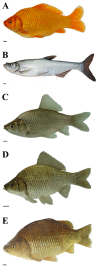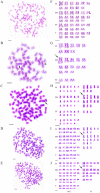Organization and variation analysis of 5S rDNA in different ploidy-level hybrids of red crucian carp × topmouth culter
- PMID: 22720007
- PMCID: PMC3377697
- DOI: 10.1371/journal.pone.0038976
Organization and variation analysis of 5S rDNA in different ploidy-level hybrids of red crucian carp × topmouth culter
Abstract
Through distant crossing, diploid, triploid and tetraploid hybrids of red crucian carp (Carassius auratus red var., RCC♀, Cyprininae, 2n = 100) × topmouth culter (Erythroculter ilishaeformis Bleeker, TC♂, Cultrinae, 2n = 48) were successfully produced. Diploid hybrids possessed 74 chromosomes with one set from RCC and one set from TC; triploid hybrids harbored 124 chromosomes with two sets from RCC and one set from TC; tetraploid hybrids had 148 chromosomes with two sets from RCC and two sets from TC. The 5S rDNA of the three different ploidy-level hybrids and their parents were sequenced and analyzed. There were three monomeric 5S rDNA classes (designated class I: 203 bp; class II: 340 bp; and class III: 477 bp) in RCC and two monomeric 5S rDNA classes (designated class IV: 188 bp, and class V: 286 bp) in TC. In the hybrid offspring, diploid hybrids inherited three 5S rDNA classes from their female parent (RCC) and only class IV from their male parent (TC). Triploid hybrids inherited class II and class III from their female parent (RCC) and class IV from their male parent (TC). Tetraploid hybrids gained class II and class III from their female parent (RCC), and generated a new 5S rDNA sequence (designated class I-N). The specific paternal 5S rDNA sequence of class V was not found in the hybrid offspring. Sequence analysis of 5S rDNA revealed the influence of hybridization and polyploidization on the organization and variation of 5S rDNA in fish. This is the first report on the coexistence in vertebrates of viable diploid, triploid and tetraploid hybrids produced by crossing parents with different chromosome numbers, and these new hybrids are novel specimens for studying the genomic variation in the first generation of interspecific hybrids, which has significance for evolution and fish genetics.
Conflict of interest statement
Figures








Similar articles
-
The formation of diploid and triploid hybrids of female grass carp × male blunt snout bream and their 5S rDNA analysis.BMC Genet. 2013 Nov 23;14:110. doi: 10.1186/1471-2156-14-110. BMC Genet. 2013. PMID: 24267392 Free PMC article.
-
Analysis of 5S rDNA organization and variation in polyploid hybrids from crosses of different fish subfamilies.J Exp Zool B Mol Dev Evol. 2010 Jul 15;314(5):403-11. doi: 10.1002/jez.b.21346. J Exp Zool B Mol Dev Evol. 2010. PMID: 20535772
-
Variations in 5S rDNAs in diploid and tetraploid offspring of red crucian carp × common carp.BMC Genet. 2017 Aug 8;18(1):75. doi: 10.1186/s12863-017-0542-2. BMC Genet. 2017. PMID: 28789633 Free PMC article.
-
The chromosomal constitution of fish hybrid lineage revealed by 5S rDNA FISH.BMC Genet. 2015 Dec 3;16:140. doi: 10.1186/s12863-015-0295-8. BMC Genet. 2015. PMID: 26635010 Free PMC article.
-
Distant hybridization leads to different ploidy fishes.Sci China Life Sci. 2010 Apr;53(4):416-25. doi: 10.1007/s11427-010-0057-9. Epub 2010 May 7. Sci China Life Sci. 2010. PMID: 20596907 Review.
Cited by
-
Dynamics of tandemly repeated DNA sequences during evolution of diploid and tetraploid botiid loaches (Teleostei: Cobitoidea: Botiidae).PLoS One. 2018 Mar 28;13(3):e0195054. doi: 10.1371/journal.pone.0195054. eCollection 2018. PLoS One. 2018. PMID: 29590207 Free PMC article.
-
The formation of diploid and triploid hybrids of female grass carp × male blunt snout bream and their 5S rDNA analysis.BMC Genet. 2013 Nov 23;14:110. doi: 10.1186/1471-2156-14-110. BMC Genet. 2013. PMID: 24267392 Free PMC article.
-
The alternative transcription and expression characterization of Dmc1 in autotetraploid Carassius auratus.Front Genet. 2023 Mar 28;14:1135006. doi: 10.3389/fgene.2023.1135006. eCollection 2023. Front Genet. 2023. PMID: 37056290 Free PMC article.
-
Cell fusion as the formation mechanism of unreduced gametes in the gynogenetic diploid hybrid fish.Sci Rep. 2016 Aug 17;6:31658. doi: 10.1038/srep31658. Sci Rep. 2016. PMID: 27530321 Free PMC article.
-
Formation of diploid and triploid hybrid groupers (hybridization of Epinephelus coioides ♀ × Epinephelus lanceolatus ♂) and their 5S gene analysis.BMC Genet. 2016 Oct 7;17(1):136. doi: 10.1186/s12863-016-0443-9. BMC Genet. 2016. PMID: 27717311 Free PMC article.
References
-
- Mallet J. Hybrid speciation. Nature. 2007;446:279–283. - PubMed
-
- Otto SP, Whitton J. Polyploid incidence and evolution. Annu Rev Genet. 2000;34:401–437. - PubMed
-
- Bullini L. Origin and evolution of animal hybrid species. Trends Ecol Evol. 1994;9:422–426. - PubMed
-
- Arnold M. Natural Hybridization and Introgression. Princeton University Press, Princeton. 1996.
Publication types
MeSH terms
Substances
LinkOut - more resources
Full Text Sources
Other Literature Sources
Research Materials

